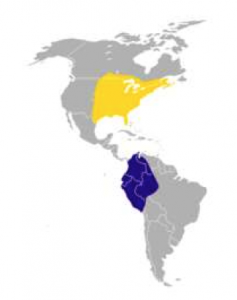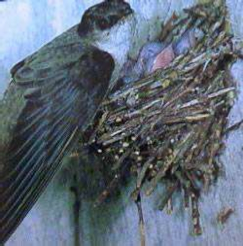by Emily Dobson
The chimney swift is a pretty remarkable species of bird when you consider its rapid adaptation over the last century. Historically, these birds inhabited old growth forests, using cavity trees or snags (standing dead trees) with large hollows for roosting and nesting. However, the European settlement and logging practises occurring into the 1900s saw the destruction of forests across North America, and with it, the loss of vital habitat for many animals including chimney swifts.

Source: “Chimney Swift range” by America_Federal_Provincial_y_Departamental is licensed under CC BY 3.0
As forests were rapidly disappearing, they were being replaced by farmland, barns, churches and houses heated using woodstoves. Conveniently, the swifts would migrate back from the Amazon basin in South America to eastern North America in late April through mid-May (Figure 1). By this time, the chimneys in these structures were no longer being used, providing artificial habitat for the aptly named birds to settle at night- time and to nest in.
The reason the chimney has served as a good alternate habitat for swifts is because of both its size and texture. The size of the chimney must be large enough for many birds, as they roost in groups that may be as large as thousands of individuals (Figure 2). This group strategy is beneficial as it provides protection (i.e. from predators) and allows the birds to maintain their body temperature during cool nights. Chimneys with brick interiors create rough vertical surfaces that allows these birds to rest against with a “fork” on their tail. Additionally, nesting birds will use chimneys for breeding, using their glue- like saliva to create half-cup nests within the chimney, with one pair of birds per structure (Figure 3).

Source: “Chimney Swift From The Crossley ID Guide Eastern Birds” by America_Federal_Provincial_y_Departamental is licensed under CC BY 3.0
Despite their rapid adaptation to man-made structures, the Canadian population of chimney swifts has drastically declined by 95% since 1968 (COSEWIC 2007). There are several explanations that may, together, contribute to these significant declines.
For starters, over the last 50 years, North Americans have further developed their heating systems, and instead of using woodstoves with chimneys, gas fireplaces or central heat are instead the norm. New buildings are no longer being built with chimneys, and buildings that have unused chimneys are being capped, lined or removed, to dissuade other creatures, like raccoons from wreaking havoc and making noise. Combined with deforestation, habitat is becoming more limited.

Mortality along their migration route may also be a factor. Significant declines are caused when hurricanes occur during migration, forcing them to re-route, or reducing food sources essential to their survival. If climate change increases the frequency of storm events, declines may continue, further reducing population sizes.
Changes in food supply may be impacting survivorship of chimney swifts. These birds are aerial insectivores, meaning they catch their prey while flying. They are in flight almost continuously throughout the day, causing them to expend a large amount of energy. Therefore, if food availability is low it can greatly impact their survival.
So what are we doing to help? Well for starters, the chimney swift is listed as “threatened” under the Endangered Species Act. Species with a threatened status receive habitat protection, and for the chimney swift, this means any repairs, modifications, maintenance, replacement or demolitions to chimneys that are suitable for habitat require certain conditions, including the following:
- The work must be registered with the Ministry of Natural Resources prior to commencement.
- Disturbance to the species must be minimized.
- Often, new habitat must be created and maintained for chimney swifts.
- Records of ongoing monitoring of the created habitat must be kept and reported.
Bird Studies Canada is conducting a long-term monitoring program, called SwiftWatch, with the goal of continuing to monitor known roosts, to find new roosts, and to raise awareness about this species at risk. The 2014 National Roost Monitoring Program is a continent-wide effort to study this species, and will be taking place May 21, 25, 29 and June 2. If you are interested in volunteering with the Halton SwiftWatch Program, or would like to know more, please use the contact form with the subject line, “Emily Dobson – SwiftWatch”.
References
Committee on the Status of Endangered Wildlife in Canada (COSEWIC). 2007. Chimney Swift.
Cornell Lab of Ornithology. 2014. Chimney Swift. Retrieved from http://www.allaboutbirds.org/guide/chimney_swift/lifehistory
LandOwner Resource Centre. 1999. The Old-Growth Forests of Southern Ontario. Retrieved from http://www.slpoa.ca/oldgwth.pdf
Ontario Government. 2013. Alter a Chimney (habitat for Chimney Swift). Retrieved from http://www.ontario.ca/environment-and-energy/alter-chimney-habitat-chimney-swift
